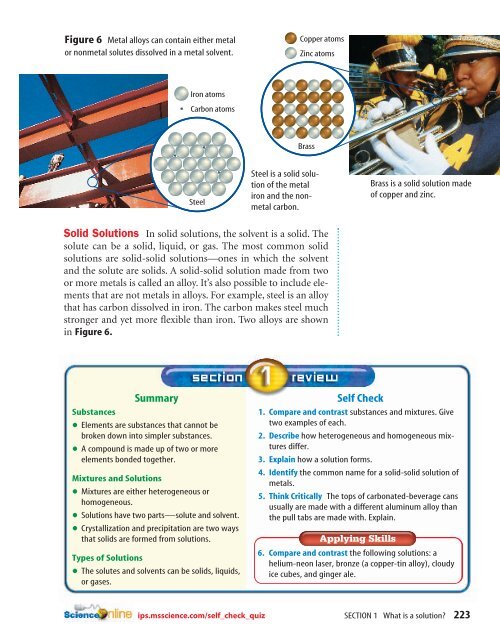Substances, Mixtures, and Solubility - McGraw-Hill Higher Education
Substances, Mixtures, and Solubility - McGraw-Hill Higher Education
Substances, Mixtures, and Solubility - McGraw-Hill Higher Education
You also want an ePaper? Increase the reach of your titles
YUMPU automatically turns print PDFs into web optimized ePapers that Google loves.
Figure 6 Metal alloys can contain either metal<br />
or nonmetal solutes dissolved in a metal solvent.<br />
Copper atoms<br />
Zinc atoms<br />
Iron atoms<br />
Carbon atoms<br />
Brass<br />
Steel<br />
Steel is a solid solution<br />
of the metal<br />
iron <strong>and</strong> the nonmetal<br />
carbon.<br />
Brass is a solid solution made<br />
of copper <strong>and</strong> zinc.<br />
Solid Solutions In solid solutions, the solvent is a solid. The<br />
solute can be a solid, liquid, or gas. The most common solid<br />
solutions are solid-solid solutions—ones in which the solvent<br />
<strong>and</strong> the solute are solids. A solid-solid solution made from two<br />
or more metals is called an alloy. It’s also possible to include elements<br />
that are not metals in alloys. For example, steel is an alloy<br />
that has carbon dissolved in iron. The carbon makes steel much<br />
stronger <strong>and</strong> yet more flexible than iron. Two alloys are shown<br />
in Figure 6.<br />
Summary<br />
<strong>Substances</strong><br />
•<br />
Elements are substances that cannot be<br />
•<br />
broken down into simpler substances.<br />
A compound is made up of two or more<br />
elements bonded together.<br />
•<br />
<strong>Mixtures</strong> <strong>and</strong> Solutions<br />
<strong>Mixtures</strong> are either heterogeneous or<br />
homogeneous.<br />
•<br />
Solutions have two parts—solute <strong>and</strong> solvent.<br />
Crystallization <strong>and</strong> precipitation are two ways<br />
that solids are formed from solutions.<br />
•<br />
Types of Solutions<br />
The solutes <strong>and</strong> solvents can be solids, liquids,<br />
or gases.<br />
Self Check<br />
1. Compare <strong>and</strong> contrast substances <strong>and</strong> mixtures. Give<br />
two examples of each.<br />
2. Describe how heterogeneous <strong>and</strong> homogeneous mixtures<br />
differ.<br />
3. Explain how a solution forms.<br />
4. Identify the common name for a solid-solid solution of<br />
metals.<br />
5. Think Critically The tops of carbonated-beverage cans<br />
usually are made with a different aluminum alloy than<br />
the pull tabs are made with. Explain.<br />
6. Compare <strong>and</strong> contrast the following solutions: a<br />
helium-neon laser, bronze (a copper-tin alloy), cloudy<br />
ice cubes, <strong>and</strong> ginger ale.<br />
ips.msscience.com/self_check_quiz<br />
SECTION 1 What is a solution 223

















